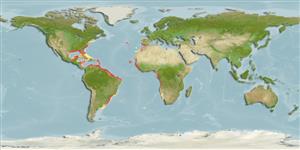Environment: milieu / climate zone / depth range / distribution range
Ökologie
seewasser; brackwasser; tiefenbereich 10 - 180 m (Ref. 27121). Subtropical; 44°N - 40°S, 97°W - 16°E
Western Atlantic: New England, USA and Bermuda to Argentina (Ref. 47377). Eastern Atlantic: Mauritania to Namibia (Ref. 27121). Southwest Atlantic: Sergipe, Brazil (Ref. 118626).
Size / Gewicht / Alter
Maturity: Lm ? range ? - ? cm
Max length : 100.0 cm TL Männchen/unbestimmt; (Ref. 3694); common length : 60.0 cm TL Männchen/unbestimmt; (Ref. 3694); max. veröff. Gewicht: 4.9 kg (Ref. 40637)
Rückenflossenstacheln (insgesamt) : 0; Rückenflossenweichstrahlen (insgesamt) : 13 - 15; Afterflossenstacheln: 0; Afterflossenweichstrahlen: 12 - 13.
Inhabits inshore and near-shore areas, over sand or mud bottoms. Usually found alone or in small, loose aggregates. Adults are pelagic, but near continental margins; young are commonly found on coastal and offshore banks (Ref. 7251). Feeds on fish and shrimps (Ref. 28587). Minimum depth from Ref. 26912. Its flesh is very delicate; nevertheless, in certain region like the Pacific and the Indian Ocean, it is toxic (particularly the skin and the viscera) (Ref. 5377). Poisonous, should not be eaten (Ref. 36731).
Life cycle and mating behavior
Geschlechtsreife | Fortpflanzung | Ablaichen | Eier | Fecundity | Larven
Shipp, R.L., 1990. Tetraodontidae. p. 1069-1072. In J.C. Quero, J.C. Hureau, C. Karrer, A. Post and L. Saldanha (eds.) Check-list of the fishes of the eastern tropical Atlantic (CLOFETA). JNICT, Lisbon; SEI, Paris; and UNESCO, Paris. Vol. 2. (Ref. 7464)
IUCN Rote Liste Status (Ref. 130435: Version 2024-1)
Nutzung durch Menschen
Fischereien: weniger kommerziell; Sportfisch: ja
Tools
Zusatzinformationen
Download XML
Internet Quellen
Estimates based on models
Preferred temperature (Ref.
123201): 16.2 - 27.3, mean 23.2 °C (based on 373 cells).
Phylogenetic diversity index (Ref.
82804): PD
50 = 0.5005 [Uniqueness, from 0.5 = low to 2.0 = high].
Bayesian length-weight: a=0.02042 (0.01599 - 0.02606), b=2.86 (2.82 - 2.90), in cm total length, based on LWR estimates for this species (Ref.
93245).
Trophic level (Ref.
69278): 4.0 ±0.69 se; based on food items.
Widerstandsfähigkeit (Ref.
120179): mittel, Verdopplung der Population dauert 1,4 - 4,4 Jahre. (Preliminary K or Fecundity.).
Fishing Vulnerability (Ref.
59153): High vulnerability (60 of 100).
Nutrients (Ref.
124155): Calcium = 36.6 [14.9, 98.0] mg/100g; Iron = 1.01 [0.54, 2.12] mg/100g; Protein = 19.5 [17.4, 21.9] %; Omega3 = 0.429 [0.191, 0.878] g/100g; Selenium = 28.5 [14.1, 56.2] μg/100g; VitaminA = 9.02 [3.40, 24.30] μg/100g; Zinc = 0.688 [0.482, 0.972] mg/100g (wet weight);
